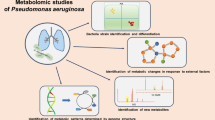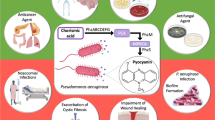Abstract
Pseudomonas aeruginosa has been identified as an important causative agent of airway infection, mainly in cystic fibrosis. This disease is characterized by defective mucociliary clearance induced in part by mucus hyper-production. Mucin is a major component of airway mucus and is heavily O-glycosylated, with a protein backbone. Airway infection is known to be established with bacterial adhesion to mucin. However, the genes involved in mucin degradation or utilization remain elusive. In this study, we sought to provide a genetic basis of P. aeruginosa airway growth by identifying those genes. First, using RNASeq analyses, we compared genome-wide expression profiles of PAO1, a prototype P. aeruginosa laboratory strain, grown in M9-mucin (M9M) and M9-glucose (M9G) media. Additionally, a PAO1 transposon (Tn) insertion mutants library was screened for mutants defective in growth in M9M medium. One mutant with a Tn insertion in the xcpU gene (PA3100) was determined to exhibit faulty growth in M9M medium. This gene contributes to the type II secretion system, suggesting that P. aeruginosa uses this secretion system to produce a number of proteins to break down and assimilate the mucin molecule. Furthermore, we screened the PAO1 genome for genes with protease activity. Of 13 mutants, one with mutation in PA3247 gene exhibited defective growth in M9M, suggesting that the PA3247-encoded protease plays a role in mucin utilization. Further mechanistic dissection of this particular process will reveal new drug targets, the inhibition of which could control recalcitrant P. aeruginosa infections.
Similar content being viewed by others
References
Bansil, R. and Turner, B.S. 2006. Mucin structure, aggregation, physiological functions and biomedical applications. Curr. Opin. Colloid Interf. Sci. 11, 164–170.
Bell, S.L., Xu, G.Q., and Forstner, J.F. 2001. Role of the cystine-knot motif at the C-terminus of rat mucin protein Muc2 in dimer formation and secretion. Biochem. J. 357, 203–209.
Bell, S.L., Xu, G., Khatri, I.A., Wang, R., Rahman, S., and Forstner, J.F. 2003. N-linked oligosaccharides play a role in disulphidedependent dimerization of intestinal mucin Muc2. Biochem. J. 373, 893–900.
Berg, J.O. 1981. Cellular localization of glycoside hydrolases in Bacteroides fragilis. Curr. Microbiol. 5, 13–17.
Bleves, S., Viarre, V., Salacha, R., Michel, G.P., Filloux, A., and Voulhoux, R. 2010. Protein secretion systems in Pseudomonas aeruginosa: a wealth of pathogenic weapons. Int. J. Med. Microbiol. 300, 534–543.
Braun, P., de Groot, A., Bitter, W., and Tommassen, J. 1998. Secretion of elastinolytic enzymes and their propeptides by Pseudomonas aeruginosa. J. Bacteriol. 180, 3467–3469.
Corfield, A.P., Wagner, S.A., Clamp, J.R., Kriaris, M.S., and Hoskins, L.C. 1992. Mucin degradation in the human colon: production of sialidase, sialate O-acetylesterase, N-acetylneuraminate lyase, arylesterase, and glycosulfatase activities by strains of fecal bacteria. Infect. Immun. 60, 3971–3978.
Davies, J.C. 2002. Pseudomonas aeruginosa in cystic fibrosis: pathogenesis and persistence. Paediatr. Respir. Rev. 3, 128–134.
Derrien, M., van Passel, M.W.J., van de Bovenkamp, J.H.B., Schipper, R., de Vos, W., and Dekker, J. 2014. Mucin-bacterial interactions in the human oral cavity and digestive tract. Gut Microbes 1, 254–268.
Fahy, J.V. and Dickey, B.F. 2010. Airway mucus function and dysfunction. New Engl. J. Med. 363, 2233–2247.
Filloux, A. and Ramos, J.L. 2014. Pseudomonas: methods and protocols. Methods in Molecular Biology. Humana Press, NY, USA.
Folders, J., Tommassen, J., van Loon, L.C., and Bitter, W. 2000. Identification of a chitin-binding protein secreted by Pseudomonas aeruginosa. J. Bacteriol. 182, 1257–1263.
Fox, A., Haas, D., Reimmann, C., Heeb, S., Filloux, A., and Voulhoux, R. 2008. Emergence of secretion-defective sublines of Pseudomonas aeruginosa PAO1 resulting from spontaneous mutations in the vfr global regulatory gene. Appl. Environ. Microbiol. 74, 1902–1908.
Frimmersdorf, E., Horatzek, S., Pelnikevich, A., Wiehlmann, L., and Schomburg, D. 2010. How Pseudomonas aeruginosa adapts to various environments: a metabolomic approach. Environ. Microbiol. 12, 1734–1747.
Fung, C., Naughton, S., Turnbull, L., Tingpej, P., Rose, B., Arthur, J., Hu, H., Harmer, C., Harbour, C., Hassett, D.J., et al. 2010. Gene expression of Pseudomonas aeruginosa in a mucin-containing synthetic growth medium mimicking cystic fibrosis lung sputum. J. Med. Microbiol. 59, 1089–1100.
Galloway, D.R. 1991. Pseudomonas aeruginosa elastase and elastolysis revisited: recent developments. Mol. Microbiol. 5, 2315–2321.
Gi, M., Jeong, J., Lee, K., Lee, K.M., Toyofuku, M., Yong, D.E., Yoon, S.S., and Choi, J.Y. 2014. A drug-repositioning screening identifies pentetic acid as a potential therapeutic agent for suppressing the elastase-mediated virulence of Pseudomonas aeruginosa. Antimicrob. Agents Chemother. 58, 7205–7214.
Gi, M., Lee, K.M., Kim, S.C., Yoon, J.H., Yoon, S.S., and Choi, J.Y. 2015. A novel siderophore system is essential for the growth of Pseudomonas aeruginosa in airway mucus. Sci. Rep. 5, 14644.
Girod, S., Zahm, J.M., Plotkowski, C., Beck, G., and Puchelle, E. 1992. Role of the physiochemical properties of mucus in the protection of the respiratory epithelium. Eur. Respir. J. 5, 477–487.
Goodman, A.L., Kulasekara, B., Rietsch, A., Boyd, D., Smith, R.S., and Lory, S. 2004. A signaling network reciprocally regulates genes associated with acute infection and chronic persistence in Pseudomonas aeruginosa. Dev. Cell 7, 745–754.
Henke, M.O., John, G., Rheineck, C., Chillappagari, S., Naehrlich, L., and Rubin, B.K. 2011. Serine proteases degrade airway mucins in cystic fibrosis. Infect. Immun. 79, 3438–3444.
Hoboth, C., Hoffmann, R., Eichner, A., Henke, C., Schmoldt, S., Imhof, A., Heesemann, J., and Hogardt, M. 2009. Dynamics of adaptive microevolution of hypermutable Pseudomonas aeruginosa during chronic pulmonary infection in patients with cystic fibrosis. J. Infect. Dis. 200, 118–130.
Hoskins, L.C., Agustines, M., McKee, W.B., Boulding, E.T., Kriaris, M., and Niedermeyer, G. 1985. Mucin degradation in human colon ecosystems. Isolation and properties of fecal strains that degrade abh blood group antigens and oligosaccharides from mucin glycoproteins. J. Clin. Invest. 75, 944–953.
Hoskins, L.C. and Boulding, E.T. 1981. Mucin degradation in human colon ecosystems. Evidence for the existence and role of bacterial subpopulations producing glycosidases as extracellular enzymes. J. Clin. Invest. 67, 163–172.
Jacobs, M.A., Alwood, A., Thaipisuttikul, I., Spencer, D., Haugen, E., Ernst, S., Will, O., Kaul, R., Raymond, C., Levy, R., et al. 2003. Comprehensive transposon mutant library of Pseudomonas aeruginosa. Proc. Natl. Acad. Sci. USA 100, 14339–14344.
Knowles, M.R. and Boucher, R.C. 2002. Mucus clearance as a primary innate defense mechanism for mammalian airways. J. Clin. Invest. 109, 571–577.
Kuang, Z., Hao, Y., Walling, B.E., Jeffries, J.L., Ohman, D.E., and Lau, G.W. 2011. Pseudomonas aeruginosa elastase provides an escape from phagocytosis by degrading the pulmonary surfactant protein-A. PLoS One 6, e27091.
Liberati, N.T., Urbach, J.M., Miyata, S., Lee, D.G., Drenkard, E., Wu, G., Villanueva, J., Wei, T., and Ausubel, F.M. 2006. An ordered, nonredundant library of Pseudomonas aeruginosa strain PA14 transposon insertion mutants. Proc. Natl. Acad. Sci. USA 103, 2833–2838.
Ma, L., Conover, M., Lu, H., Parsek, M.R., Bayles, K., and Wozniak, D.J. 2009. Assembly and development of the Pseudomonas aeruginosa biofilm matrix. PLoS Pathog. 5, e1000354.
Macfarlane, S., Quigley, M.E., Hopkins, M.J., Newton, D.F., and Macfarlane, G.T. 1998. Polysaccharide degradation by human intestinal bacteria during growth under multi-substrate limiting conditions in a three-stage continuous culture system. FEMS Microbiol. Ecol. 26, 231–243.
Macfarlane, S., Woodmansey, E.J., and Macfarlane, G.T. 2005. Colonization of mucin by human intestinal bacteria and establishment of biofilm communities in a two-stage continuous culture system. Appl. Environ. Microbiol. 71, 7483–7492.
Martínez, A., Ostrovsky, P., and Nunn, D.N. 1999. LipC, a second lipase of Pseudomonas aeruginosa, is LipB and Xcp dependent and is transcriptionally regulated by pilus biogenesis components. Mol. Microbiol. 34, 317–326.
McConoughey, S.J., Howlin, R., Granger, J.F., Manring, M.M., Calhoun, J.H., Shirtliff, M., Kathju, S., and Stoodley, P. 2014. Biofilms in periprosthetic orthopedic infections. Future Microbiol. 9, 987–1007.
O'Toole, G.A. and Kolter, R. 1998. Initiation of biofilm formation in Pseudomonas fluorescens WCS365 proceeds via multiple, convergent signalling pathways: a genetic analysis. Mol. Microbiol. 28, 449–461.
Oh, Y.T., Lee, K.M., Bari, W., Raskin, D.M., and Yoon, S.S. 2015. (p)ppGpp, a small nucleotide regulator, directs the metabolic fate of glucose in Vibrio cholerae. J. Biol. Chem. 290, 13178–13190.
Palmer, K.L., Mashburn, L.M., Singh, P.K., and Whiteley, M. 2005. Cystic fibrosis sputum supports growth and cues key aspects of Pseudomonas aeruginosa physiology. J. Bacteriol. 187, 5267–5277.
Pettipher, G.L. and Latham, M.J. 1979. Production of enzymes degrading plant cell walls and fermentation of cellobiose by Ruminococcus flavefaciens in batch and continuous culture. J. Gen. Microbiol. 110, 29–38.
Porras-Gomez, M., Vega-Baudrit, J., and Nunez-Corrales, S. 2012. Overview of multidrug-resistant Pseudomonas aeruginosa and novel therapeutic approaches. J. Biomater. Nanobiotechnol. 3, 519–527.
Rabiu, B.A. and Gibson, G.R. 2002. Carbohydrates: a limit on bacterial diversity within the colon. Biol. Rev. Camb. Philos. Soc. 77, 443–453.
Rogan, M.P., Geraghty, P., Greene, C.M., O'Neill, S.J., Taggart, C.C., and McElvaney, N.G. 2006. Antimicrobial proteins and polypeptides in pulmonary innate defence. Respir. Res. 7, 1–11.
Sabaeifard, P., Abdi-Ali, A., Soudi, M.R., and Dinarvand, R. 2014. Optimization of tetrazolium salt assay for Pseudomonas aeruginosa biofilm using microtiter plate method. J. Microbiol. Methods 105, 134–140.
Senturk, S., Ulusoy, S., Bosgelmez-Tinaz, G., and Yagci, A. 2012. Quorum sensing and virulence of Pseudomonas aeruginosa during urinary tract infections. J. Infect. Dev. Ctries 6, 501–507.
Son, M.S., Matthews, W.J.Jr., Kang, Y., Nguyen, D.T., and Hoang, T.T. 2007. In vivo evidence of Pseudomonas aeruginosa nutrient acquisition and pathogenesis in the lungs of cystic fibrosis patients. Infect. Immun. 75, 5313–5324.
Strateva, T. and Mitov, I. 2011. Contribution of an arsenal of virulence factors to pathogenesis of Pseudomonas aeruginosa infections. Ann. Microbiol. 61, 717–732.
Thornton, D.J. and Sheehan, J.K. 2004. From mucins to mucus: toward a more coherent understanding of this essential barrier. Proc. Am. Thorac. Soc. 1, 54–61.
Tsukatani, T., Suenaga, H., Higuchi, T., Akao, T., Ishiyama, M., Ezoe, K., and Matsumoto, K. 2008. Colorimetric cell proliferation assay for microorganisms in microtiter plate using watersoluble tetrazolium salts. J. Microbiol. Methods 75, 109–116.
Turner, B.S., Bhaskar, K.R., Hadzopoulou-Cladaras, M., and LaMont, J.T. 1999. Cysteine-rich regions of pig gastric mucin contain von Willebrand factor and cystine knot domains at the carboxyl terminal. Biochim. Biophys. Acta 1447, 77–92.
van’t Wout, E.F., van Schadewijk, A., van Boxtel, R., Dalton, L.E., Clarke, H.J., Tommassen, J., Marciniak, S.J., and Hiemstra, P.S. 2015. Virulence factors of Pseudomonas aeruginosa induce both the unfolded protein and integrated stress responses in airway epithelial cells. PLoS Pathog. 11, e1004946.
Voulhoux, R., Ball, G., Ize, B., Vasil, M.L., Lazdunski, A., Wu, L.F., and Filloux, A. 2001. Involvement of the twin-arginine translocation system in protein secretion via the type IIpathway. EMBO J. 20, 6735–6741.
Yoon, S.S., Coakley, R., Lau, G.W., Lymar, S.V., Gaston, B., Karabulut, A.C., Hennigan, R.F., Hwang, S.H., Buettner, G., Schurr, M.J., et al. 2006. Anaerobic killing of mucoid Pseudomonas aeruginosa by acidified nitrite derivatives under cystic fibrosis airway conditions. J. Clin. Invest. 116, 436–446.
Yoon, S.S. and Hassett, D.J. 2004. Chronic Pseudomonas aeruginosa infection in cystic fibrosis airway disease: Metabolic changes that unravel novel drug targets. Expert. Rev. Anti. Infect. Ther. 2, 611–623.
Yoon, M.Y., Lee, K.M., Park, Y., Yoon, S.S., and Kaushal, D. 2011. Contribution of cell elongation to the biofilm formation of Pseudomonas aeruginosa during anaerobic respiration. PLoS One 6, e16105.
Author information
Authors and Affiliations
Corresponding author
Rights and permissions
About this article
Cite this article
Alrahman, M.A., Yoon, S.S. Identification of essential genes of Pseudomonas aeruginosa for its growth in airway mucus. J Microbiol. 55, 68–74 (2017). https://doi.org/10.1007/s12275-017-6515-3
Received:
Revised:
Accepted:
Published:
Issue Date:
DOI: https://doi.org/10.1007/s12275-017-6515-3




